Catching Up After Cavallino
1/28/12
Catching Up After Cavallino

A couple of weeks ago, we agreed to look at a 330 GTC. There was a short list of “to dos” that I checked off to make this car “perfect” for the new owner. The final issue on the car, was a pesky “pop and spit” right around 3000-3500 rpm. A popping issue can be a number of things, and usually requires going through the simple things first, eliminating each system that can affect engine tune.
Since this was a new purchase, we were told the car was freshly tuned, but when we tried adjusting the carburetors, the misfire was still there. As the list of simple fixes were eliminated, we realized the problem was not so easy of a fix. We tried to gather as much information on what was done to the engine from the owner, and previous shop, but we learned the pop and spit was never eliminated from previous attempts, and perhaps the problem was passed on for a reason. While researching the previous work, I worked at getting everything on the ignition system spot on. We found hotter plugs were installed, which we replaced. I found one distributor phased 1 degree off from its opposite point set so that was corrected. During our carb cleaning and inspection, we found the jetting slightly off factory specs, but nothing too out of the ordinary. Even though we experienced small improvements, the pesky spitting at that particular RPM range under load was still there. 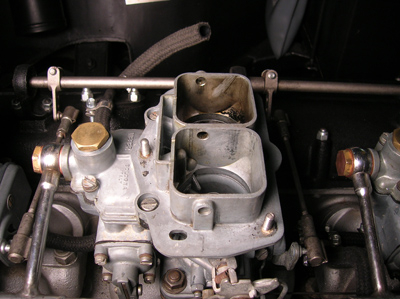
On our test drives, we found an interesting phenomena, the spitting was only coming from one side. Black deposits from the back firing was only collecting on the right side of the carburetors. This clue pointed to something perhaps happening with the cam timing. Francois explained that if the cam timing was off, the intake charge could be ignited by a delayed exhaust event. Unfortunately, the only way to check this was in pulling off the cam covers for a closer inspection.
Cam timing is one of those “black arts” in Ferrari engine building. There are factory marks for cams when the engine was originally installed, but these marks become less valid when an engine is rebuilt. Cams twist, heads get shaved, and timing chains stretch, all changing the relationship between the position of the cam and the pistons. There are marks on the flywheel that show where the valve timing should be, and by following these marks, one can accurately “time” the cam to match these marks. When camshafts twist, however, not only does the mechanic have to check the timing of the cam on one set of lobes, but also where the cam lobes are from one end to the other. If there is twist, the mechanic then has to find a happy medium to set the cam. The only better solution would be to regrind the cam, and set it to factory specs.
With the valve covers off, Francois found exactly what we expected. The right bank of cylinders, one through six, were off. There was a slight twist in the cam, and the valves timing was not exactly matching the marks on the flywheel. Francois made his best guess to set the cam timing taking into account of the twist, and reassembled the valve covers.
I called him from Cavallino and he gave me the bad news.
The Frenchman said, “Ess, better, but steel bad!”
I felt horrible about being in Florida, while Francois was dealing with such a problematic car. Not to mention I brought this car into our shop as a quick “in and out!”
Francois said something was still wrong, but he would keep plugging away at it. I know Francois does not like to be defeated with something he is an expert at, and without a solution, it eats away at him. Going home for me was not going to be fun.
I let Francois work while I busied myself with the other cars in the shop. By the end of the day, Francois came back from a test drive with a big smile on his face, and motioned me to jump in the passenger seat. As we took our usual route, the spit and pop was gone! Amazed and elated, I asked what he had done. Basically, Francois created a restrict or plate on the carbs to determine if there was a lean issue with the carbs, and it eliminated the problem. He finally found the silver bullet to the problem.
Although he still had more testing and tuning, Francois was on the right track. These carburetors will have to be re jetted to run much richer than factory spec, but we think with the better valve timing, we’ll find the sweet spot. I spoke to Mike Pierce of Pierce Manifold after our discovery, and he had a similar issue with a GTC. It was nice to hear we weren’t the only ones struggling!
Although this is just a theory, I believe others have tried to fix this problem before. The missing choke plates and hotter plugs, all point to someone trying different things on this engine. The missing combination may have been cam timing and carb jetting. Let’s hope we can button things up this week, and GET THIS CAR OUT OF HERE!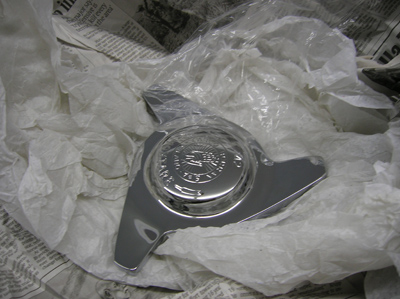
The knock offs came back from Cork Adams this week, and they look great. They went immediately back on 2259, the Survivor GTE.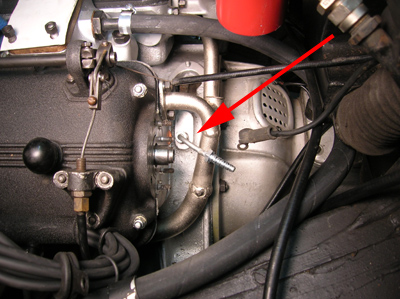
Now that the engine is installed, I started working on fabricating new oil lines to the gauges. Unfortunately, the rear oil line fitting required I remove the 7/12 distributor so I could install the line. After carefully marking the position of the distributor, I removed the distributor/angle drive, and had clear access to the line.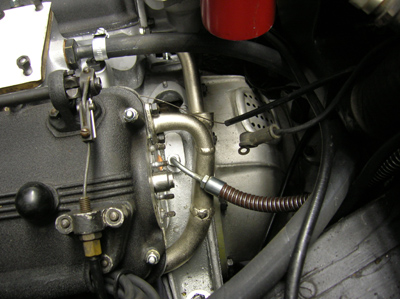
The new line was fabricated, and attached. 
The seat cushions came back from our upholsters, and so far, they look great. I’ll have to fit the seat backs on to see how everything fits back together.
It was time to check the car’s electrics. There was something monumental about this task as lights that have not been on in 40 years came to life. There were a couple electrical issues that needed to be addressed like blown bulbs and dodgy connectors, but generally, everything worked!
Then there was the case with the Series III tail lights…This car’s serial number, 2259, places her as a Series I car with the vertically stacked round tail lights, but this car has later Series III tail lights. The story is the first owner of this car used to take the car back to the Factory for service, and on one visit, they installed the newer lights. Series III tail lights do not simply bolt on to a SI car, so there is a chrome filler piece behind these lights.
As I was checking the electrics on this car, I found the reverse lights were not hooked into the wiring harness. Normally, SI cars had a single reverse light mounted below the center of the bumper, but looking closely, this car had no hole or mount for this light. As I traced the wiring, I found the reverse light harness but it was neatly tucked away back into the main harness on both sides. After I made a new harness, and connected all the wires, we had reverse lights!
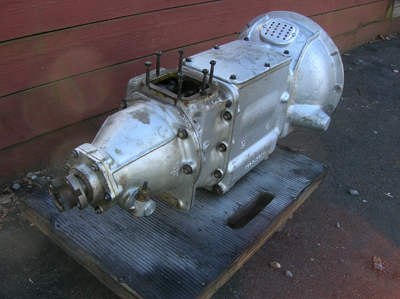
A client of mine has a Lusso Transmission for sale. It’s a 250 4-speed transmission. If anyone is interested, let me know.
Reminder: If you have a Ferrari related project, car, or idea you’d like to explore, I’d love to talk to you. I can also help if you’re thinking of buying or selling. This website represents what I love to do, and now it’s how I make a living, so if you’d like to do something together, let me know. It all begins with an e-mail!
Previous Restoration Day
Next Restoration Day
Home page




